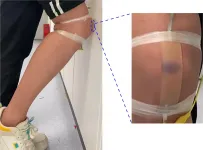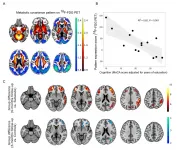(Press-News.org) NEW YORK, NY (June 16, 2021)--Spectacular images of a molecule that shuttles omega-3 fatty acids into the brain may open a doorway for delivering neurological therapeutics to the brain.
"We've managed to obtain a three-dimensional structure of the transporter protein that provides a gateway for omega-3s to enter the brain. In this structure, we can see how omega-3s bind to the transporter. This information may allow for the design of drugs that mimic omega-3s to hijack this system and get into the brain," says first author Rosemary J. Cater, PhD, a Simons Society Fellow in the Mancia Lab at Columbia University Vagelos College of Physicians and Surgeons.
The study was published online on June 16 in the journal Nature.
A major challenge in treating neurological diseases is getting drugs across the blood-brain barrier--a layer of tightly packed cells that lines the brain's blood vessels and zealously blocks toxins, pathogens, and some nutrients from entering the brain. Unfortunately, the layer also blocks many drugs that are otherwise promising candidates to treat neurological disorders.
Essential nutrients like omega-3s require the assistance of dedicated transporter proteins that specifically recognize them and get them across this barrier. "The transporters are like bouncers at a club, only letting molecules with invites or backstage passes in," Cater says.
The transporter--or bouncer--that lets omega-3s in is called MFSD2A and is the focus of Cater's research. "Understanding what MFSD2A looks like and how it pulls omega-3s across the blood-brain barrier may provide us with the information we need to design drugs that can trick this bouncer and gain entry passes."
To visualize MFSD2A, Cater used a technique called single-particle cryo-electron microscopy.
"The beauty of this technique is that we're able to see the shape of the transporter with details down to a fraction of a billionth of a meter," says study co-leader Filippo Mancia, PhD, associate professor of physiology & cellular biophysics at Columbia University Vagelos College of Physicians and Surgeons and an expert in the structure and function of membrane proteins. "This information is critical for understanding how the transporter works at a molecular level."
For cryo-EM analysis, protein molecules are suspended in a thin layer of ice under an electron microscope. Powerful cameras take millions of pictures of the proteins from countless angles which can then be pieced together to construct a 3D map.
Into this map researchers can build a 3D model of the protein, putting each atom in its place. "It reminds me of solving a jigsaw puzzle," Mancia explains. This technique has become remarkably powerful in visualizing biological molecules in recent years, thanks in part to Joachim Frank, PhD, professor of biochemistry & molecular biophysics at Columbia University Vagelos College of Physicians and Surgeons, who won the Nobel Prize in 2017 for his role in developing cryo-electron microscopy data analysis algorithms.
"Our structure shows that MFSD2A has a bowl-like shape and that omega-3s bind to a specific side of this bowl," Cater explains. "The bowl is upside down and faces the inside of the cell, but this is just a single 3D snapshot of the protein, which in real life has to move to transport the omega-3s. To understand exactly how it works, we need either multiple different snapshots or, better yet, a movie of the transporter in motion."
To understand what these movements might look like, a second co-leader of the study, George Khelashvili, PhD, assistant professor of physiology and biophysics at Weill Cornell Medicine, used the 3D model of the protein as a starting point to run computational simulations that revealed how the transporter moves and adapts its shape to release omega-3s into the brain. A third co-leader of the study, David Silver, PhD, professor at the Duke-NUS Medical School in Singapore and pioneer in MFSD2A biology, together with his team tested and confirmed hypotheses derived from the structure and the computational simulations on how MFSD2A works to pinpoint specific parts of the protein that are important.
The team also included researchers from the New York Structural Biology Center, the University of Chicago, and the University of Arizona, all using their specific skills to make this project possible.
The team is now investigating how the transporter first recognizes omega-3s from the bloodstream. "But our study has already given us tremendous insight into how MFSD2A delivers omega-3s to the brain, and we are really excited to see where our results lead to," Cater says.
INFORMATION:
More Information
The study is titled "Structural basis of omega-3 fatty acid transport across the blood-brain barrier."
Other authors: Geok Lin Chua (Duke-NUS Medical School), Satchal K. Erramilli (University of Chicago), James E. Keener (University of Arizona), Brendon C. Choy (Columbia), Piotr Tokarz (University of Chicago), Cheen Fei Chin (Duke-NUS Medical School), Debra Q.Y. Quek (Duke-NUS Medical School), Brian Kloss (New York Structural Biology Center), Joseph G. Pepe (Columbia), Giacomo Parisi (Columbia), Bernice H. Wong (Duke-NUS Medical School), Oliver B. Clarke (Columbia), Michael T. Marty (University of Arizona), and Anthony A. Kossiakoff (University of Chicago).
The study was supported by funds from the National Institutes of Health (R35 GM132120, R21 MH125649, R35 GM128624, and R01 GM117372); the National Research Foundation and Ministry of Health, Singapore; the Simons Society of Fellows; the HRH Prince Alwaleed Bin Talal Bin Abdulaziz Alsaud Institute of Computational Biomedicine at Weill Cornell Medical College through the 1923 Fund; and the Khoo Postdoctoral Research Fellowship.
David Silver is a scientific founder and advisor of Travecta Therapeutics, which has developed a drug delivery platform that uses MFSD2A transport. All other authors declare no competing interests.
Columbia University Irving Medical Center provides international leadership in basic, preclinical, and clinical research; medical and health sciences education; and patient care. The medical center trains future leaders and includes the dedicated work of many physicians, scientists, public health professionals, dentists, and nurses at the Vagelos College of Physicians and Surgeons, the Mailman School of Public Health, the College of Dental Medicine, the School of Nursing, the biomedical departments of the Graduate School of Arts and Sciences, and allied research centers and institutions. Columbia University Irving Medical Center is home to the largest medical research enterprise in New York City and State and one of the largest faculty medical practices in the Northeast. For more information, visit cuimc.columbia.edu or columbiadoctors.org.
Bay Area scientists have captured the real-time electrical activity of a beating heart, using a sheet of graphene to record an optical image -- almost like a video camera -- of the faint electric fields generated by the rhythmic firing of the heart's muscle cells.
The graphene camera represents a new type of sensor useful for studying cells and tissues that generate electrical voltages, including groups of neurons or cardiac muscle cells. To date, electrodes or chemical dyes have been used to measure electrical firing in these cells. But electrodes and dyes measure the voltage at one point only; a graphene sheet measures the voltage ...
Should zoos display legally protected species that have been smuggled out of their range countries? A new study suggests that a pause and rethink may be needed, as it reports that accredited zoos have acquired a rare and legally protected reptile, the earless monitor lizard endemic to Borneo, without any evidence that the animals were legally exported.
The earless monitor lizard occurs only on the island of Borneo and has been described as a "miniature Godzilla" and "the Holy Grail of Herpetology." Discovered by western scientists almost 150 years ago, for most of this period the species was known largely from pickled specimens in natural history collections, and wasn't recorded from ...
American Indian and Alaska Native Enrollment in Clinical Studies in the National Institutes of Health's Intramural Research Program
Dejonna Vigil, Ninet Sinaji, and Barbara Karp
This is the first study to provide data about the inclusion of American Indians and Alaska Natives in the National Institutes of Health's Intramural Research Program (NIH-IRP), which provides eligible individuals with access to innovative research treatments that may not otherwise be available. The program's mission is to include all Americans. This study analyzed data from more than 1,800 NIH-IRP protocols active in 2014 and 2017. While the number of American ...
When someone bumps their elbow against a wall, they not only feel pain but also might experience bruising. Robots and prosthetic limbs don't have these warning signs, which could lead to further injury. Now, researchers reporting in ACS Applied Materials & Interfaces have developed an artificial skin that senses force through ionic signals and also changes color from yellow to a bruise-like purple, providing a visual cue that damage has occurred.
Scientists have developed many different types of electronic skins, or e-skins, that can sense stimuli through electron transmission. However, these electrical conductors are not always biocompatible, which could limit their use in some types of prosthetics. In contrast, ionic skins, or I-skins, ...
Researchers at Karolinska Institutet in Sweden found industrial chemicals in the organs of fetuses conceived decades after many countries had banned the substances. In a study published in the journal Chemosphere, the researchers urge decision makers to consider the combined impact of the mix of chemicals that accumulate in people and nature.
"These are important findings that call for regulators to consider the collective impact of exposure to multiple chemicals rather than evaluating just one chemical at a time," says first author Richelle Duque Björvang, PhD student at the Department of Clinical ...
As consumers and corporations alike become more environmentally conscious, the chemical industry is working to find solutions to the plastic waste crisis. One idea is to use biodegradable polymers known as polyhydroxyalkanoates (PHA) as replacements for traditional plastic packaging and other materials. A feature article in Chemical & Engineering News, the weekly newsmagazine of the American Chemical Society, explores the possibilities and pitfalls of PHA.
PHA is not a new human invention; this class of polymers can be found in nature and is used to store cellular energy, writes Senior Editor Alex Tullo. Commercially, it is manufactured through the industrial fermentation of sugars or lipids. As cities ...
Researchers from the Singapore University of Technology and Design (SUTD) have demonstrated a technology that rapidly detects pollutants in water by measuring their impacts on swimming microorganisms.
Their proof-of-concept, published in Scientific Reports, does not require any chemicals, reagents or laboratory equipment. Instead, it leverages the regular camera of a smartphone as well as microorganisms called Paramecia that are ubiquitous in water bodies--making it especially suitable for assessing water drinkability in underdeveloped regions.
Typically, levels of environmental pollutants are measured by assessing their impact on a given population. Though such impacts may be visible after several days for microorganisms, it takes several years for the true scale to be ...
People with a rare autoimmune disease, who likely experience more serious isolation during a global pandemic, saw their anxiety and depression improve after receiving online mental health intervention through an international study involving investigators from Michigan Medicine.
The paper, END ...
Reston, VA--The effects of COVID-19 on the brain can be accurately measured with positron emission tomography (PET), according to research presented at the Society of Nuclear Medicine and Molecular Imaging (SNMMI) 2021 Annual Meeting. In the study, newly diagnosed COVID-19 patients, who required inpatient treatment and underwent PET brain scans, were found to have deficits in neuronal function and accompanying cognitive impairment, and in some, this impairment continued six months after their diagnosis. The detailed depiction of areas of cognitive impairment, neurological symptoms and comparison of impairment over a six-month time frame has been selected as SNMMI's 2021 Image of the Year.
Each year, SNMMI chooses an image that best exemplifies the most promising ...
LMU researchers have identified the 14-3-3sigma gene as an important suppressor of carcinogenesis in the gastrointestinal tract.
Intestinal cancers, also known as colorectal cancer, are among the most prevalent forms of malignancy worldwide. If detected early enough, tumors can be surgically excised. However, as cancer growth progresses, cells may escape from the primary tumor, which can then establish metastatic tumors in other organs. Once such satellite tumors have formed, survival rates fall significantly. Formation of the initial tumor can be triggered by mutations in any of a number of genes. Together with postdocs ...


